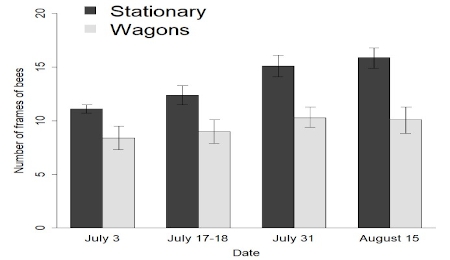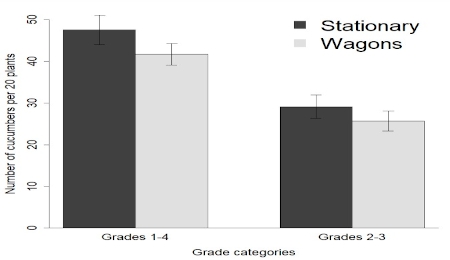Placing honey bee hives
During cucumber pollination, honey bee hives are either left along a field edge for the summer or kept on wagons and moved between smaller plantings (Figure 2). Moving is stressful for bees and can affect their ability pollinate your crop, especially if done during the day. If hives are moved when the foragers are out, they will not find the new colony location. When hives are moved short distances and remain in the original flight range, foragers may use old landmarks and return to the initial (now hiveless) location. Losing foragers is not good. Since only certain bees in the hive forage (and provide pollination while foraging), moving hives may mean that you lose all the bees you need to pollinate your cucumbers!
MSU researchers investigated the effects of moving colonies on bee health and crop yield
Impact on honey bee colonies
We compared growth of stationary honey bee colonies to colonies on wagons on multiple cucumber fields in eastern Michigan. All the colonies grew throughout the season (Figure 3), but growth was greater in stationary colonies. After eight weeks, stationary colonies grew by 43.2% while colonies in wagons grew only 19.4%. This difference in relative colony growth is substantial. Compared to moved colonies, the stationary colonies contained 20% more bees, almost the equivalent of an additional hive. Smaller colonies with fewer workers not only mean fewer bees available to visit cucumber flowers, but it also it means more work and expense for your beekeepers, which may lead to higher rental prices.

Figure 3. Growth of honey bee colonies over the summer, as measured by the number of frames per hive covered in worker bees.
Impact on cucumber yield
During 2017 and 2018, we measured cucumber yield in 21 fields across central and eastern Michigan: 14 fields were pollinated exclusively by stationary hives and seven fields were pollinated exclusively by hives on wagons. Yield was assessed by collecting 20 plants selected randomly from across the whole field two days before harvest. All cucumbers were stripped from plants and graded, according to United States Department of Agriculture (USDA) standards. Fields pollinated by stationary colonies had higher set rates and a greater number of high-quality sizes (average of 47.6 grade one to four cucumbers per 20 plants, with an average of 29.1 grade two to three cucumbers) (Figure 4). Fields pollinated by colonies on wagons had a lower set rate and fewer high-quality sizes (41.7 grade one to four cucumbers and 25.7 grade two to three cucumbers). Overall, fields using stationary colonies had 14% more grade one to four cucumbers per plant and 13% more grade two to three cucumbers per plant.

Figure 4. Cucumber yields in fields with hives that are stationary compared to hives that were moved on wagons.
Summary
We found that moving hives on wagons reduced the growth of honey bee colonies and slightly reduced cucumber yield. Because honey bee workers can fly several miles to forage, where cucumber plantings are close together (less than 1 mile from hives) we recommend leaving hives in a single location throughout summer. Colonies will grow to a greater size, contain more worker bees and these bees will visit more flowers. If plantings are too far apart, then colonies should be moved at night time to avoid the loss of foraging workers.
Source : msu.edu